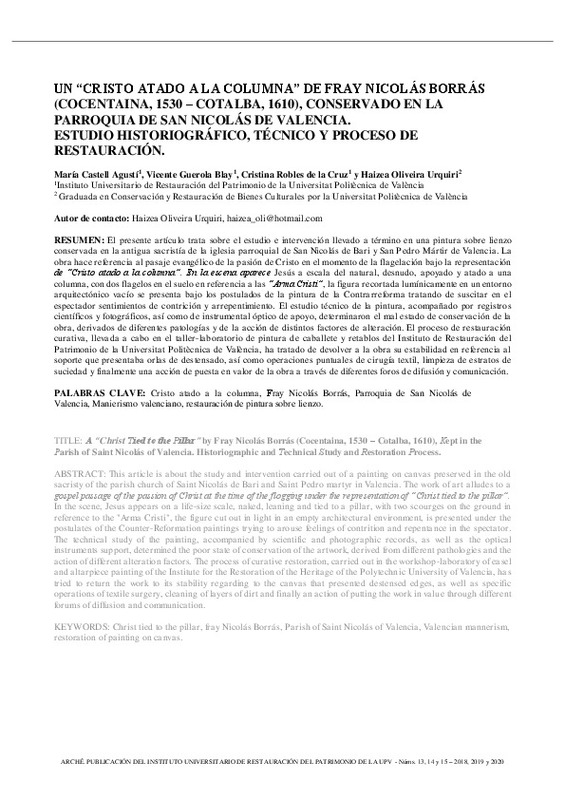JavaScript is disabled for your browser. Some features of this site may not work without it.
Buscar en RiuNet
Listar
Mi cuenta
Estadísticas
Ayuda RiuNet
Admin. UPV
Un “Cristo atado a la columna” de Fray Nicolás Borrás (Cocentaina, 1530 – Cotalba, 1610), conservado en la Parroquia de San Nicolás de Valencia. Estudio historiográfico, técnico y proceso de restauración
Mostrar el registro completo del ítem
Castell Agustí, M.; Guerola Blay, V.; Robles De La Cruz, C.; Oliveira Urquiri, H. (2020). Un “Cristo atado a la columna” de Fray Nicolás Borrás (Cocentaina, 1530 – Cotalba, 1610), conservado en la Parroquia de San Nicolás de Valencia. Estudio historiográfico, técnico y proceso de restauración. Arché. (13 - 14 - 15):41-50. http://hdl.handle.net/10251/156354
Por favor, use este identificador para citar o enlazar este ítem: http://hdl.handle.net/10251/156354
Ficheros en el ítem
Metadatos del ítem
| Título: | Un “Cristo atado a la columna” de Fray Nicolás Borrás (Cocentaina, 1530 – Cotalba, 1610), conservado en la Parroquia de San Nicolás de Valencia. Estudio historiográfico, técnico y proceso de restauración | |
| Autor: | Robles de la Cruz, Cristina | |
| Entidad UPV: |
|
|
| Fecha difusión: |
|
|
| Resumen: |
[ES] El presente artículo trata sobre el estudio e intervención llevado a término en una pintura sobre lienzo conservada en la antigua sacristía de la iglesia parroquial de San Nicolás de Bari y San Pedro Mártir de Valencia. ...[+]
[EN] This article is about the study and intervention carried out of a painting on canvas preserved in the old sacristy of the parish church of Saint Nicolás de Bari and Saint Pedro martyr in Valencia. The work of art ...[+]
|
|
| Palabras clave: |
|
|
| Derechos de uso: | Reserva de todos los derechos | |
| Fuente: |
|
|
| Editorial: |
|
|
| Tipo: |
|







